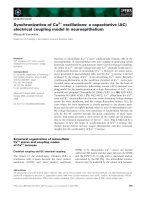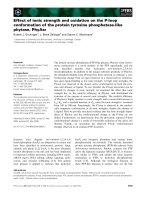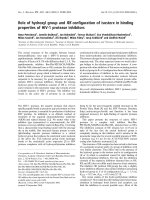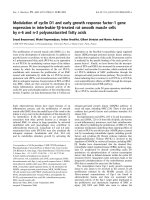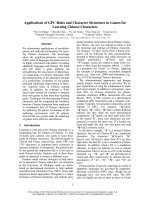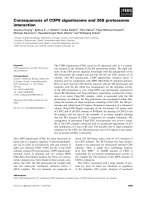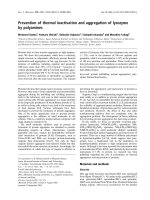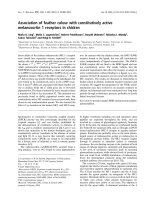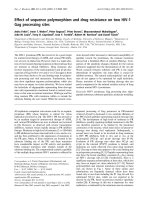Báo cáo khoa học: Colocalization of insulin receptor and insulin receptor substrate-1 to caveolae in primary human adipocytes Cholesterol depletion blocks insulin signalling for metabolic and mitogenic control doc
Bạn đang xem bản rút gọn của tài liệu. Xem và tải ngay bản đầy đủ của tài liệu tại đây (427.94 KB, 9 trang )
Colocalization of insulin receptor and insulin receptor substrate-1
to caveolae in primary human adipocytes
Cholesterol depletion blocks insulin signalling for metabolic and mitogenic control
Margareta Karlsson
1
, Hans Thorn
1
, Anna Danielsson
1
, Karin G. Stenkula
1
, Anita O
¨
st
1
, Johanna Gustavsson
1
,
Fredrik H. Nystrom
2
and Peter Stra
˚
lfors
1
1
Department of Cell Biology and Diabetes Research Centre, and
2
Department of Medicine and Care and Diabetes Research Centre,
University of Linko
¨
ping, Sweden
Caveolae are plasma membrane invaginations with several
functions, one of which appears to be to organize receptor
mediated signalling. Here we report that in primary human
subcutaneous adipocytes the insulin receptor was localized
to caveolae by electron microscopy/immunogold detection
and by isolating caveolae from plasma membranes. Part of
insulin receptor substrate 1 (IRS1), the immediate down-
stream signal mediator, was colocalized with the insulin
receptor in the plasma membrane and caveolae, as demon-
strated by immunofluorescence microscopy, immunogold
electron microscopy, and immunogold electron microscopy
of transfected recombinant HA-IRS1. In contrast, rat epi-
didymal adipocytes lacked IRS1 at the plasma membrane.
Depletion of cholesterol from the cells using b-cyclodextrin
blocked insulin stimulation of glucose uptake, insulin
inhibition of perilipin phosphorylation in response to iso-
proterenol, and insulin stimulation of protein kinase B and
Map-kinases extracellular signal-related kinase (ERK)1/2
phosphorylation. Insulin-stimulated phosphorylation of
the insulin receptor and IRS1 was not affected, indicating
that caveolae integrity is required downstream of IRS1. In
conclusion we show that insulin receptor and IRS1 are both
caveolar proteins and that caveolae are required for both
metabolic and mitogenic control in human adipocytes. Our
results establish caveolae as foci of insulin action and stress
the importance of examining human cells in addition to
animal cells and cell lines.
Keywords: extracellular signal-related kinase; ultrastructure;
protein kinase B; b-cyclodextrin; glucose transport.
Insulin exerts control over cell metabolism by binding to its
cell surface receptor, which has been characterized in great
detail [1–5]. The occupied receptor is autophosphorylated
on tyrosine residues and can thereby tyrosine phosphorylate
other cellular proteins, to transduce the insulin signal into
the signal network of the cell. Chief among these proteins
are the insulin receptor substrate (IRS) family of proteins
[1]. When tyrosine is phosphorylated they can transmit
metabolic and mitogenic signals. The further downstream
events involve the generation of second messengers and
phosphorylation of protein kinase B/Akt (PKB). Eventually
glucose transporter GLUT4 is translocated to the plasma
membrane for glucose uptake and other target proteins (e.g.
perilipin [6]) are phosphorylated/dephosphorylated. Insu-
lin’s ability for mitogenic signalling is transmitted via the
Map-kinases extracellular signal-related kinase (ERK)1/2
for phosphorylation control of transcription factors. The
precise mechanisms for insulin’s cellular control are not yet
known in detail, and especially not so in human cells and
tissues.
Caveolae are 25–150 nm invaginations of the plasma
membrane and are found in most cell types. They are
particularly abundant in rat adipocytes and increase
dramatically in number when 3T3-L1 fibroblasts are
differentiated into fat cells and become insulin responsive
[7–9]. Cholesterol and sphingolipids together with the
principal structural protein caveolin are required for caveo-
lae to form. Caveolae are involved in numerous cellular
processes such as receptor mediated uptake, receptor
mediated signalling, and vesicular trafficking, reviewed in
[10]. A number of proteins involved in signal transduction
have been found in caveolae [11–15]. We have shown that in
rat adipocytes and in 3T3-L1 adipocytes the insulin receptor
is localized to caveolae [16,17]. The immediate downstream
signal-mediator IRS1, on the other hand, has been reported
not to be associated with the plasma membrane in rat
adipocytes [18] or in other cell types [19–21]. In rat
adipocytes the disruption of caveolar integrity by cholesterol
depletion using b-cyclodextrin, reversibly made the cells
insulin resistant by inhibiting the insulin receptor from
phosphorylating IRS1. On the other hand, insulin signalling
for mitogenic control via Map-kinases ERK1 and 2 was not
impaired in the rat cells [17,22]. The importance of caveolae
for insulin action is reinforced by the finding that, in
response to insulin stimulation, the insulin regulated glucose
transporter GLUT4 is translocated to caveolae for glucose
Correspondence to P. Stralfors, Department of Cell Biology and
Diabetes Research Centre, University of Linko
¨
ping, SE58185
Linko
¨
ping, Sweden. Fax: + 46 13 224314, Tel.: + 46 13 224315,
E-mail:
Abbreviations: ERK, extracellular signal-related kinase; GLUT4,
insulin-stimulated glucose transporter 4; IRS, insulin receptor sub-
strate; Map, mitogen activated protein; PKB, protein kinase B;
TEM, transmission electron microscopy.
(Received 11 March 2004, revised 16 April 2004,
accepted 21 April 2004)
Eur. J. Biochem. 271, 2471–2479 (2004) Ó FEBS 2004 doi:10.1111/j.1432-1033.2004.04177.x
uptake [9,23,24], and that some of the downstream
signalling for enhanced glucose uptake may take place in
caveolae [25].
The role of caveolae in insulin signalling has, however,
not been examined in human cells. As animal cells in general
and immortalized cell lines in particular often deviate from
primary human cells, which are the cells most relevant to the
study of human disease, we set out to investigate this in
human adipocytes. Here we report that in primary human
adipocytes the insulin receptor along with its immediate
downstream signal mediator IRS1 is localized in caveolae of
the plasma membrane. Destruction of caveolae interrupts
insulin signal transduction downstream of IRS1 and makes
these cells insulin resistant to both metabolic and mitogenic
signalling.
Materials and methods
Subjects
Samples of subcutaneous abdominal fat were obtained,
after the informed consent, from patients (male or female,
age 40–76 years) undergoing elective abdominal surgery at
the University Hospital of Linko
¨
ping. Patients diagnosed
with diabetes were excluded. The Local Ethics Committee
approved the study.
Materials
Rabbit anti-insulin receptor b-chain and anti-caveolin
polyclonal and mouse anti-phosphotyrosine (PY20) mono-
clonal antibodies were from Transduction Laboratories
(Lexington, KY, USA). Rabbit anti-phospho(Thr308)-
PKB/Akt polyclonal antibodies were from Upstate Biotech
(Charlottesville, VI, USA). Rabbit polyclonal antibodies
against phospho-ERK1/2 and against phospho-p38 Map-
kinase were from Cell Signalling Techn. (Beverly, MA,
USA). Anti-insulin receptor b-chain monoclonal, anti-IRS1
rabbit polyclonal antibodies (sc-559, sc-560), and anti-HA
rabbit polyclonal antibodies were from Santa Cruz
Biotechnology (Santa Cruz, CA, USA). Colloidal gold
conjugated anti-(IgG) Ig was from Aurion (Wageningen,
the Netherlands). 2-Deoxy-
D
-[1-
3
H] glucose was from
Amersham Biotech (UK). Insulin, b-cyclodextrin, and other
chemicals were from Sigma-Aldrich (St Louis, MO, USA)
or as indicated in the text.
Isolation and incubation of adipocytes
Human adipocytes were isolated by collagenase (type 1;
Worthington, NJ, USA) digestion as described [26] except
that the cells were allowed to floatate by gravity. At a final
concentration of 100 lL packed cell volume per ml, cells
were incubated in Krebs–Ringer solution (0.12
M
NaCl,
4.7 m
M
KCl, 2.5 m
M
CaCl
2
,1.2m
M
MgSO
4
,1.2m
M
KH
2
PO
4
) containing 20 m
M
Hepes, pH 7.40, 1% (w/v)
fatty acid-free bovine serum albumin, 100 n
M
phenyliso-
propyladenosine, 0.5 UÆmL
)1
adenosine deaminase with
2m
M
glucose, at 37 °C on a shaking water bath. For
analysis of b-cyclodextrin effects on insulin control of
insulin receptor, IRS1, PKB, ERK1/2, and p38, cells were
incubated overnight before analysis. Rat adipocytes were
isolated [26] from the epididymal adipose tissue of
Sprague–Dawley rats (130–160 g, B and K Universal,
Sollentuna, Sweden). The animals were treated in accor-
dance with Swedish Animal Care regulations.
Transfection of adipocytes with myc-tagged caveolin-1
or HA-tagged IRS1
Isolated adipocytes were transfected as follows: 200 lLcells
(400 lL cell volume per ml) was mixed with 200 lLof
buffer (137 m
M
NaCl, 2.7 m
M
KCl, 10 m
M
Na
2
HPO
4
and
1.8 m
M
KH
2
PO
4
, pH 7.5) containing 5 lg of empty vector
pcis2, pcis2-myc-caveolin-1, or pcis2-HA-IRS1 (kindly
supplied by M. Quon, NIH, Bethesda, MD, USA) in an
electroporation cuvette. Cells were electroporated with 6
pulses at 600 V and 25 lF using Gene pulser II (Bio-Rad).
Cells from 15 cuvettes were pooled and kept at 37 °Cin
10% (v/v) CO
2
. After 1 h an equal volume of Dulbecco’s
modified Eagle’s medium pH 7.5, containing 25 m
M
glu-
cose, 50 unitsÆmL
)1
penicillin, 50 lgÆmL
)1
streptomycin,
200 n
M
phenylisopropyladenosine, 7% (w/v) bovine serum
albumin, and 25 m
M
Hepes, was added. After 18 h of
incubation cells were collected and plasma membranes
prepared for electron microscopy.
Electron microscopy of plasma membranes
Plasma membrane sheets were prepared for electron
microscopy as described previously [27]. After rinsing the
adipocytes in ice-cold phosphate-buffer (10 m
M
Na
2
HPO
4
/
NaH
2
PO
4
, 150 m
M
NaCl, pH 7.5) they were attached
to nickel grids [28]: poly(
L
-lysine) and formvar coated
grids were rehydrated by floating on ice-cold phosphate-
buffer containing the cells. Grids with captured adipocytes
were flushed with ice-cold 150 m
M
KCl, 1.9 m
M
Tris/HCl
buffer, pH 7.6. Plasma membranes remaining on the
grids were washed three times in 150 m
M
Hepes,
pH 7.5, and fixed in 0.1
M
sodium cacodylate buffer,
containing 0.1
M
sucrose, 3% (w/v) paraformaldehyde,
and 0.05% (v/v) glutaraldehyde, for 30 min at room
temperature.
Plasma membranes were blocked for 1 h in phosphate-
buffer, containing 5% (w/v) bovine serum albumin (BSA-c,
Aurion, the Netherlands), 0.1% (w/v) gelatine, and 5%
normal goat serum (Aurion) at 37 °C. This was followed by
incubation with mouse anti-insulin receptor b-chain mono-
clonal antibodies, or anti-IRS1 polyclonal antibodies, or
rabbit anti-caveolin polyclonal antibodies for 1.5 h at
37 °C. Grids were rinsed with phosphate-buffer, containing
0.1% (w/v) BSA-c before incubation with secondary
antibodies. Goat anti-(rabbit IgG) Ig and/or goat anti-
(mouse IgG) Ig, conjugated with 15 nm or 6 nm colloidal
gold, was added to plasma membranes and incubated
overnight at 4 °C.
After immunolabelling, the plasma membranes were
rinsed and fixed in 2% (v/v) glutaraldehyde for 10 min
followed by 1% (w/v) OsO
4
for 30 min in 0.1
M
sodium
cacodylate buffer, with 0.1
M
sucrose, pH 7.5, at room
temperature. Grids were rinsed with water, frozen, lyo-
philized, and coated with 2 nm tungsten by magnetron
sputtering directly in the freeze-dryer [29]. Transmission
electron microscopy was performed with Jeol EM1230
2472 M. Karlsson et al. (Eur. J. Biochem. 271) Ó FEBS 2004
TEM-SCAN (Tokyo, Japan). No labelling was observed
in the absence of primary antibody, nor was any
cross-reactivity detected between secondary and primary
antibodies.
Immunofluorescence microscopy of plasma membrane
sheets
Plasma membrane sheets were prepared as described [17, 30]
and fixed in 3% (w/v) paraformaldehyde for 30 min at
room temperature. After blocking in bovine serum albumin
and gelatine membranes were incubated with rabbit anti-
IRS1, caveolin, or insulin receptor antibodies. Primary
antibodies were detected with fluorescent secondary anti-
bodies (Alexa fluor 488 or 594, from Molecular Probes,
USA) by fluorescence microscopy (Nikon, D-Eclipse CI
confocal microscope, Tokyo, Japan). No labelling was
observed in the absence of the primary antibody, nor was
any cross-reactivity detected between secondary and pri-
mary antibodies.
Isolation of caveolae-enriched membrane fraction
A caveolae-enriched membrane fraction was isolated as
described [22]. Adipocytes were homogenized in 10 m
M
Tris/HCl, pH 7.4, 1 m
M
EDTA, 0.5 m
M
EGTA, 0.25
M
sucrose, 25 m
M
NaF, 1 m
M
pyrophosphate with protease
inhibitors (10 l
M
leupeptin, 1 l
M
pepstatin, 1 l
M
apro-
tinin, 4 m
M
iodoacetate and 50 m
M
phenylmethanesulfo-
nyl fluoride) using a motor-driven Teflon/glass
homogenizer at room temperature. Subsequent proce-
dures were carried out at 0–4 °C. A plasma membrane
containing pellet, obtained by centrifugation at 16 000 g
for 20 min, was resuspended in 10 m
M
Tris/HCl, pH 7.4,
1m
M
EDTA and protease inhibitors. Purified plasma
membranes were isolated by sucrose gradient centrifuga-
tion [31,32], referred to as the plasma membrane fraction.
Aliquots of plasma membrane fraction were pelleted and
resuspended in 0.5
M
Na
2
CO
3
, pH 11, and protease
inhibitors [33], and sonicated with a probe-type sonifier
(MSE, Soniprep 150) 3 · 20 s. The homogenate was then
adjusted to 45% sucrose in 12 m
M
Mes, pH 6.5, 75 m
M
NaCl, 0.25
M
Na
2
CO
3
and loaded under a 5–35%
discontinuous sucrose gradient in the same buffer and
centrifuged at 39 000 r.p.m. for 16–20 h in a SW41 rotor
(Beckman Instruments, Fullerton, CA, USA). The light-
scattering band at the 5–35% sucrose interface, enriched
in caveolae, was collected and referred to as the caveolae
fraction. A cytosolic fraction was obtained as the
supernatant from centrifuging the 16 000 g supernatant
at 150 000 g 75 min and discarding the pellet. One third
of the plasma membrane from rat adipocytes constitutes
caveolae membrane [27], which thus is a minimum figure
for human adipocyte plasma membranes that have a
higher density of caveolae. To examine the purity of our
caveolae preparation we isolated nuclear and mitochond-
rial membranes, which are the chief contaminants of
adipocyte plasma membrane [31], and identified seven
proteins by peptide sequence analysis using collision
induced dissociation and electrospray ionization mass
spectrometry. The same analysis was performed in
parallel on the caveolae fraction and no nuclear/
mitochondrial contamination was detected (N. Aboulaich,
J. Vainonen, P. Stra
˚
lfors, and A. Vener, unpublished
data).
SDS/PAGE and immunoblotting
Proteins were separated by SDS/PAGE, transferred to a
poly(vinylidene difluoride) blotting membrane (Immobi-
lone-P, Millipore, Bedford, MA, USA), and incubated with
indicated primary antibodies. Bound antibodies were
detected using Renaissence+ (New England Nuclear) with
horseradish peroxidase-conjugated anti-IgG as secondary
antibody. Blots were evaluated by chemiluminescence
imaging (Las1000, Fuji, Japan). By two-dimensional elec-
trofocusing (pH 3–10) SDS/PAGE [34] analysis and immu-
noblotting against phosphotyrosine and IRS1, we found
that > 95% of the tyrosine phosphorylated 180 kDa band
represents IRS1.
Cholesterol and protein determination
Cholesterol was quantitated spectrofluorometrically [35] by
measuring the amount of H
2
O
2
produced by cholesterol
oxidase (Rhodococus erythropolis, from Boehringer Mann-
heim, Mannheim, Germany) on a Fluoroscan spectrofluo-
rometer (Labsystems, Finland). Protein was determined
with the Micro BCA kit from Pierce. Bovine serum albumin
wasusedasstandard.
Determination of glucose transport
Glucose transport was determined as uptake of 2-deoxy-
D
-[1-
3
H]glucose [36] after transfer of cells to medium
without glucose. Cells were treated with or without insulin
for 15 min when 2-deoxy-
D
-[1-
3
H]glucose was added to a
final concentration of 50 l
M
(10 lCiÆmL
)1
)andthecells
were incubated for another 30 min; uptake was linear for at
least 30 min. Glucose uptake was stopped by centrifuging
through dinonylphtalate and freezing in an aluminium
block kept at )20 °C. Non-specific uptake was determined
in the presence of 25 l
M
cytochalasin B by terminating the
incubation immediately after addition of the 2-deoxy-
D
-[1-
3
H]glucose. Tubes were cut frozen through the
oil-layer, the cell cakes were dissolved in 0.4 mL 1% (w/v)
SDS, and radioactivity was measured in 3 mL of scintillant
(QuickSafe A, Zinsser Analytic Ltd).
Perilipin protein phosphorylation analysis
For analysis of protein phosphorylation, adipocytes (50 lL
packed cell volume per ml) were prelabelled with [
32
P]phos-
phate for 1 h [37]. Total cell protein was prepared for SDS/
PAGE as described [26].
32
P-incorporation in perilipin was
evaluated by radioimaging (Bas1000, Fuji).
Results
Localization of the insulin receptor in caveolae
of human adipocytes
We analyzed isolated adipocytes from human abdominal
subcutaneous adipose tissue. As seen by transmission
Ó FEBS 2004 Insulin receptor and IRS1 in caveolae (Eur. J. Biochem. 271) 2473
electron microscopy, the inside of the plasma membrane of
a human fat cell was covered with large numbers of
caveolae. These were seen as bulbs protruding from the
plasma membrane, either singularly (Fig. 1A) or in clusters
of varying size (Figs 1B and 2). Caveolae clusters were
frequent in the plasma membrane of these cells, in contrast
to rat adipocytes [27]. The caveolae structures were labelled
with antibodies against the caveolae specific protein caveolin
(6 nm gold particles) and against the insulin receptor
(15 nm gold particles). Labelling of the insulin receptor
was largely restricted to the caveolae structures: as single
caveolae (Fig. 1A) or in clusters of caveolae (Fig. 1B).
A close up view of a single caveola showed that only the
neck attaching the caveolar bulb to the plasma membrane
was significantly labelled by antibodies against caveolin
(Fig. 2). The specific localization of caveolin in the necks of
caveolae has been described for rat adipocytes [27] and
human fibroblasts [27]. We verified this finding here by
transfecting human adipocytes with myc-tagged caveolin-1
and examination with gold-conjugated antibodies against
the myc tag. Only the necks and not the bulbs of caveolae
were labelled (not shown).
We also isolated a caveolae fraction, without using
detergent [17], from purified human adipocyte plasma
membranes and examined the presence of insulin receptor
by immunoblotting after gel electrophoresis. The insulin
receptor was present and enriched in this caveolae fraction,
compared to the total plasma membrane fraction (Fig. 3A).
The chief structural constituents of caveolae, caveolin
(Fig. 3C), and cholesterol (0.59 ± 0.05 nmol cholesterol
Fig. 1. Transmission electron microscopy of the inside of human adi-
pocyte plasma membrane. Plasma membrane sheets were immunogold
labelled against the insulin receptor (15 nm gold particles, black
arrowheads) and caveolin (6 nm gold particles, white arrowheads). (A)
Membrane area with single caveolae, (B) a cluster of caveolae. Images
contrast inverted.
Fig. 2. Stereo image of a human adipocyte caveola by transmission
electron microscopy. Plasma membrane sheets were immunogold
labelled against the insulin receptor (15 nm gold particle, black
arrowheads) and caveolin (6 nm gold particles, white arrowheads).
Image contrast inverted.
Fig. 3. Insulin receptor in plasma membrane and isolated caveolae
fractions. Human adipocytes were incubated with or without 1 n
M
insulin for 20 min, as indicated; plasma membrane (pm) and caveolae
(cav) fractions were prepared. Aliquots of 3 lg protein was subjected
to SDS/PAGE and immunoblotting with antibodies against (A) the
insulin receptor b-subunit, (B) phospho-tyrosine and (C) caveolin.
2474 M. Karlsson et al. (Eur. J. Biochem. 271) Ó FEBS 2004
per lgprotein(mean±SE,n ¼ 6) in the caveolae fraction
and 0.31 ± 0.02 in the plasma membrane fraction), were
also enriched. The enrichment was compatible with caveo-
lae constituting between a third and half of the plasma
membrane; in human adipocytes the numerous caveolae
clusters increase the caveolae membrane more than in rat
adipocytes, which have a third of their plasma membrane
being caveolae [27].
Insulin receptor signalling in caveolae
We next examined the functional status of caveolae-
localized receptors. After incubating cells with a submax-
imal concentration of insulin the insulin-induced increase in
receptor autophosphorylation was comparable in the iso-
lated caveolae fraction and in the total plasma membrane
fraction (Fig. 3B).
We have previously shown that reduction of the amount
of cholesterol in the plasma membrane with b-cyclodextrin
destroys the structural integrity of caveolae [27]. Depletion
of cholesterol made the human adipocytes insulin resistant:
insulin stimulation of glucose uptake was impaired by prior
cholesterol depletion, but without any effect on the basal
glucose uptake (Fig. 4). The protein perilipin is believed to
be involved in the hormonal regulation of lipolysis [6].
Insulin’s ability to counteract catecholamine-stimulated
phosphorylation of perilipin was also inhibited by the
cholesterol depletion (Fig. 5).
In line with these findings, insulin signalling to increased
phosphorylation of protein kinase B (Fig. 6A) was
curtailed. The insulin-stimulated phosphorylation of Map-
kinases ERK1 and 2 (Fig. 6B) was also attenuated by
b-cyclodextrin. In contrast, insulin-stimulated phosphory-
lation (Fig. 6C) of the insulin receptor was not affected by
this level of prior cholesterol depletion, nor was the total
tyrosine phosphorylation of IRS1 affected (Fig. 6D). A
more detailed examination of the effect of cholesterol
depletion, at different concentrations of insulin, still failed to
Fig. 4. Effect of cholesterol depletion on insulin control of glucose up-
take. Isolated human adipocytes were incubated with (closed symbols)
or without (open symbols) 10 m
M
b-cyclodextrin for 50 min and were
then incubated with the indicated concentration of insulin for 15 min.
2-Deoxyglucose uptake was then determined. Because the maximal
response to insulin was variable between individuals (131, 53, and
58 nmol 2-deoxyglucoseÆmin
)1
ÆmL
)1
packed cells), glucose uptake was
normalized to the maximal uptake for each experiment and expressed
aspercentofmax.Mean±SE,n ¼ 3 separate experiments of three
determinations each on cells from three subjects.
Fig. 5. Effect of cholesterol depletion on insulin control of perilipin
phosphorylation. Isolated human adipocytes were incubated with or
without 10 m
M
b-cyclodextrin (bCD)asindicatedfor50minandthen
they were incubated with 20 n
M
isoproterenol (iso) or 20 n
M
isopro-
terenol and 1 n
M
insulin (iso + ins), or with vehicle (contr) for 15 min.
Shown is the
32
P-phosphorylation of perilipin after SDS/PAGE of
whole-cell lysates. The indicated doublet represents perilipin; the
phosphorylation is typically shifted from the lower molecular mass
band to an enhanced phosphorylation of the higher molecular mass
band in response to cyclic AMP elevation [6].
Fig. 6. Effect of cholesterol depletion on insulin signal mediators.
Human adipocytes were treated with or without 7 m
M
b-cyclodextrin
for 50 min, and then incubated with or without 10 n
M
insulin for
20 min, as indicated. Whole-cell lysate aliquots were subjected to SDS/
PAGE and immunoblotting with antibodies against (A) phospho-
PKB; (B) phospho-ERK1/2; (C) phospho-tyrosine (insulin receptor
b-subunit); (D) phospho-tyrosine (IRS1).
Ó FEBS 2004 Insulin receptor and IRS1 in caveolae (Eur. J. Biochem. 271) 2475
reveal any significant effects on insulin receptor (Fig. 7A) or
IRS1 (Fig. 7B) phosphorylation at any concentration of the
hormone. However, as we determined total tyrosine-phos-
phorylation of IRS1, we cannot rule out effects on specific
phosphorylation sites on the protein.
Localization of IRS1 in the plasma membrane and
caveolae of human adipocytes
As IRS1 phosphorylation by the insulin receptor was not
dependent on plasma membrane cholesterol/caveolae integ-
rity, as has been found to be the case in rat adipocytes [22],
we examined if IRS1 was localized in the plasma membrane
and caveolae in human adipocytes. Immunofluorescence
microscopy of plasma membrane sheets, from cells not
exposed to insulin, using anti-IRS1 Igs revealed that IRS1
was localized in the plasma membrane (Fig. 8B). Antibodies
against different epitopes (N- and C-terminal) of the protein
similarly detected IRS1 in the plasma membrane. In
contrast, under identical conditions, IRS1 was repeatedly
not detected by immunofluorescence microscopy in the
plasma membrane of rat epididymal adipocytes (Fig. 8E).
The punctuate pattern of IRS1 binding in the plasma
membrane (Fig. 8B) suggested that part of IRS1 may be
associated with caveolae and hence the insulin receptor. To
examine the possibility of caveolar localization of IRS1 we
analyzed plasma membrane sheets for colocalization with
caveolin (Fig. 8A–C) or the insulin receptor (Fig. 9A–C).
The merged immunofluorescence images for IRS1 and
caveolin or IRS1 and the insulin receptor indicates
colocalization (as demonstrated by the yellow colour) of
IRS1 with both caveolin and the insulin receptor.
To further examine a caveolar localization of IRS1 we
next examined plasma membrane sheets by electron micro-
scopy after immunogold labelling with antibody against
IRS1 (Fig. 10A,B). IRS1 was detected in the caveolae
structures as well as outside: 63% of IRS1 was found in
caveolae (293 of 567 identified gold particles, from 10
different cells, were found in or directly associated with
caveolae structures, which constituted 30% of the plasma
membrane sheets examined). Similar results were obtained
with antibodies against the N- and against the C-terminal
part of IRS1. IRS1 remained bound to the plasma
membrane after depletion of cholesterol with b-cyclodextrin
(not shown).
To dispel any uncertainty of antibody cross-reactivity and
detection of other plasma membrane and caveolar proteins,
we transfected human adipocytes with the human IRS1
with an HA-tag (hemagglutinin) and used immunogold-
antibodies against the HA-tag to examine IRS1 localization
in the human adipocyte plasma membrane. Figure 10C
shows that the HA-tag of HA-IRS1 was detected by
electron microscopy in the plasma membrane and in
caveolae, similarly to the findings with antibody against
the wild-type IRS1.
Discussion
Our findings demonstrate that caveolae are central to
insulin action in human adipocytes, similarly to the
previously described situation in rat and 3T3-L1 adipo-
cytes [15,17,22–24]: the insulin receptor in human adipo-
cytes is located in caveolae, is autophosphorylated in
caveolae, and is dependent on caveolae for its cellular
control. Intriguingly, in human adipocytes the immediate
downstream signal mediator IRS1 was, under basal
noninsulin-stimulated conditions, colocalized with the
insulin receptor in caveolae. In type 2 diabetes the tissues
respond poorly to insulin, exhibiting insulin resistance that
can be overcome by increasing concentrations of circula-
ting insulin. In the majority of cases it is still not known
what defect in the insulin target cell causes insulin
resistance. Our finding that insulin’s cellular control is
dependent on caveolae/cholesterol in human adipocytes
indicates that caveolae has to be taken into account when
trying to understand normal insulin signal transduction as
well as the dysfunction that causes insulin resistance in
different human conditions.
Fig. 7. Effect of cholesterol depletion on dose–response effect of insulin
on tyrosine phosphorylation of insulin receptor and IRS1. Human adi-
pocytes were treated with (closed symbols) or without (open symbols)
7m
M
b-cyclodextrin for 50 min, and incubated with indicated con-
centration of insulin for 20 min. Whole-cell lysate aliquots were sub-
jected to SDS/PAGE and immunoblotting with antibodies against (A)
phospho-tyrosine (insulin receptor b-subunit) or (B) phospho-tyrosine
(IRS1). It was verified that in each experiment insulin-stimulated
phosphorylation of PKB was blocked. Insulin-stimulated phosphory-
lation was obtained by setting the value with no insulin to 0% and at
100 n
M
insulin to 100% effect. Dose–response curves were fitted to
experimental data using the sigmoid dose–response algorithm in
GraphPad Prism 3 software. Mean ± SE, n ¼ 5subjects.
2476 M. Karlsson et al. (Eur. J. Biochem. 271) Ó FEBS 2004
We found that in human adipocytes IRS1 is associated
with the plasma membrane and the caveolae, and hence in
close proximity to the insulin receptor. This finding was
demonstrated by immunofluorescence microscopy and
immunogold electron microscopy, using antibodies against
the N- or C-terminal part of the protein, thus reducing the
possibility of antibodies crossreacting with and detecting an
unrelated plasma membrane/caveolae protein. Moreover,
transfected cells expressed HA-IRS1 in the caveolae and the
plasma membrane as analyzed with antibodies against the
HA-tag. Plasma membrane sheets on grids were extensively
washed before incubation with the antibodies, thus reducing
the possibility of unspecific binding of IRS1 to the plasma
membrane. Also, after the same treatment no IRS1 was
associated with the plasma membrane in rat epididymal
adipocytes. In rat adipocytes (herein and [18]) and other
cells [19–21] IRS1 has been shown not to be associated with
the plasma membrane, but has been found in the cytosol or
bound to intracellular membranes and the cytoskeleton,
pointing to the importance of exercising great caution when
extrapolating to the situation in human beings from findings
in animal cells and cell lines commonly used.
A consequence of IRS1 localization in the plasma
membrane and caveolae appears to be that depletion of
cholesterol and destruction of caveolae does not block
insulin interaction with and stimulation of IRS1 tyrosine
phosphorylation as happens in rat adipocytes [22], but
instead blocks the further downstream phosphorylation of
PKB and the target effects on glucose uptake and perilipin
phosphorylation. It can be hypothesized that the occupied
Fig. 8. IRS1 colocalization with caveolin in the plasma membrane. Plasma membrane sheets attached to glass cover-slips were incubated with
antibodies against caveolin and against the C-terminal part of IRS1. (A–C) Human adipocyte examined by immunofluorescence microscopy using
red fluorescent antibodies against caveolin (A) and green fluorescent antibodies against IRS1 (B); merged image (C). (D–F) Rat adipocyte examined
by immunofluorescence microscopy using green fluorescent antibodies against caveolin (D) and red fluorescent antibodies against IRS1 (E); merged
image (F).
Fig. 9. IRS1 colocalization with the insulin receptor in the plasma membrane. Plasma membrane sheets attached to glass coverslips were incubated
with antibodies against the insulin receptor and IRS1, and examined by immunofluorescence microscopy using green fluorescent antibodies for the
insulin receptor (A) and red fluorescent antibodies for IRS1 (B); merged image (C).
Ó FEBS 2004 Insulin receptor and IRS1 in caveolae (Eur. J. Biochem. 271) 2477
insulin receptor and, in human adipocytes, tyrosine-phos-
phorylated IRS1 have to be internalized via caveolae in
order to interact with and activate downstream signal
mediators. Our finding then poses the question of IRS2
localization in these cells. Differential localization of IRS1
and IRS2 could explain why IRS1 is a preferred mediator of
insulin signalling under normal conditions. Receptor inter-
nalization by way of caveolae was recently reported for the
kinin B(2) receptor [38]. Intriguingly, it has been suggested
that a larger cyclic AMP response to stimulation of the
b1-compared to the b2-adrenergic receptor in rat cardio-
myocytes depends on colocalization of the b1-receptor, but
not the b2-receptor, with the downstream mediator adenylyl
cyclase in caveolae [39]. It will be important to examine the
mechanism for IRS1 binding to caveolae in the human fat
cells and whether this binding is subject to control, by, e.g.
insulin. Human IRS1 does not contain the consensus
sequence for binding to caveolin, as has been described for a
number of signalling proteins including the insulin receptor
[40].
A further property that distinguishes primary human
from rat adipocytes was that insulin stimulation to increased
phosphorylation of Map-kinases ERK1/2 was blocked by
cholesterol depletion/caveolae destruction in the human
cells. This is contrary to the situation in rat adipocytes,
where only metabolic and not mitogenic control by insulin
was dependent on intact caveolae [22]. Apparently this
difference reflects different properties of insulin receptor
signalling in rat and human tissues. This again stresses
the importance of examining human cells and tissues.
b-Cyclodextrin is widely used to control cellular levels of
cholesterol through its ability to mildly extract cholesterol
from the plasma membrane of intact cells without
itself incorporating into the membrane. The effects of
b-cyclodextrin treatment were critically dependent on its
concentration. The effective concentration had to be
experimentally tried out for each batch of the compound,
which varied between manufacturers and between different
lots from the same manufacturer.
In conclusion, we report that in human adipocytes
caveolae contain the insulin receptor and its immediate
downstream signal mediator IRS1, and that cholesterol
depletion and caveolae destruction make these cells insulin
resistant, downstream of IRS1, for both metabolic and
mitogenic control.
Acknowledgements
We thank Kurt Borch, Preben Kjolhede, and colleagues at the
departments of Surgery and Obstetrics at the University Hospital in
Linko
¨
ping for providing us with adipose tissue. Financial support was
obtained from Lions Foundation, Swedish Society for Medical
Research, Swedish National Board for Laboratory Animals, O
¨
stergo
¨
t-
land County Council’s Medical Research Funds, Swedish Foundation
for Strategic Research (National Network for Cardiovascular
Research), Swedish Diabetes Association and the Swedish Research
Council.
References
1. Yenush, L. & White, M.F. (1997) The IRS-signalling system
during insulin and cytokine action. Bioessays 19, 491–500.
2. Olefsky, J.M. (1990) The insulin receptor a multifunctional pro-
tein. Diabetes 39, 1009–1016.
3. White, M.F. & Kahn, C.R. (1994) The insulin signaling system.
J. Biol. Chem. 269, 1–4.
4. Cohen, P. (1999) Identification of a protein kinase cascade of
major importance in insulin signal transduction. Philos. Trans.
Royal Soc. 354, 485–495.
5. Nystro
¨
m, F.H. & Quon, M.J. (1999) Insulin signalling: metabolic
pathways and mechanisms for specificity. Cell. Sign. 11, 563–574.
Fig. 10. IRS1 localization in the plasma membrane and caveolae by
electron microscopy. Plasma membrane sheets attached to grids were
incubated with antibodies against IRS1 N-terminus (A,B). Human
adipocytes were transfected with the recombinant gene for HA-IRS1.
Plasma membrane sheets attached to grids were then incubated with
antibodies against the HA-tag (C). After incubation with colloidal
gold-derivatized secondary antibodies (15 nm gold particles, arrow-
heads) membranes were examined by transmission electron micros-
copy. Images contrast inverted.
2478 M. Karlsson et al. (Eur. J. Biochem. 271) Ó FEBS 2004
6. Clifford, G.M., Londos, C., Kraemer, F.B., Vernon, R.G. &
Yeaman, S.J. (2000) Translocation of hormone-sensitive lipase
and perilipin upon lipolytic stimulation of rat adipocytes. J. Biol.
Chem. 275, 5011–5015.
7. Fan, J.Y., Carpentier, J.L., Obberghen, E.V., Grunfeld, C.,
Gorden, P. & Orci, L. (1983) Morphological changes of the 3T3-
L1 fibroblast plasma membrane upon differentiation to the adi-
pocyte form. J. Cell Sci. 61, 219–230.
8. Kandror, K.V., Stephens, J.M. & Pilch, P.F. (1995) Expression
and compartmentalization of caveolin in adipose cells: coordinate
regulation with and strucural segregation from GLUT4. J. Cell
Biol. 129, 999–1006.
9. Scherer, P.E., Lisanti, M.P., Baldini, G., Sargiacomo, M., Corley
Mastick, C. & Lodish, H.F. (1994) Induction of caveolin during
adipogenesis and association of GLUT4 with caveolin-rich vesi-
cles. J. Cell Biol. 127, 1233–1243.
10. Razani, B., Woodman, S.E. & Lisanti, M.P. (2002) Caveolae:
from cell biology to animal physiology. Pharmacol. Rev. 54,
431–467.
11. Smart, E.J., Graf, G.A., McNiven, M.A., Sessa, W.C., Engelman,
J.A., Scherer, P.E., Okamoto, T. & Lisanti, M.P. (1999) Caveolins,
liquid-ordered domains and signal transduction. Mol. Cell. Biol.
19, 7289–7304.
12. Anderson, R.G.W. (1998) The caveolae membrane system. Annu.
Rev. Biochem. 67, 199–225.
13. Kurzchalia, T.V. & Parton, R.G. (1999) Membrane microdo-
mains and cavolae. Curr. Opin. Cell. Biol. 11, 424–431.
14. Simons, K & Ikonen, E. (1997) Functional rafts in cell mem-
branes. Nature 387, 569–572.
15. Cohen, A.W., Combs, T.P., Scherer, P.E. & Lisanti, M.P. (2003)
Role of caveolin and caveolae in insulin signaling and diabetes.
Am. J. Physiol. 285, E1151–E1160.
16. Stra
˚
lfors, P. (1997) Insulin second messengers. Bioessays 19,
327–335.
17. Gustavsson, J., Parpal, S., Karlsson, M., Ramsing, C., Thorn, H.,
Borg, M., Lindroth, M., Peterson, K.H., Magnusson, K.E. &
Stra
˚
lfors, P. (1999) Localisation of the insulin receptor in caveolae
of adipocyte plasma membrane. FASEB J. 13, 1961–1971.
18.Anai,M.,Ono,H.,Funaki,M.,Fukushima,Y.,Inukai,K.,
Ogihara, T., Sakoda, H., Onishi, Y., Yazaki, Y., Kikuchi, M.,
Oka, Y. & Asano, T. (1998) Different subcellular distribution and
regulation of expression of insulin receptor substrate (IRS) -3 from
those of IRS-1 and IRS-2. J. Biol. Chem. 273, 29686–29692.
19.Inoue,G.,Cheatham,B.,Emkey,R.&Kahn,C.R.(1998)
Dynamics of insulin signaling in 3T3-L1 adipocytes. Differential
compartmentalization and trafficking of insulin receptor substrate
(IRS)-1 and IRS-2. J. Biol. Chem. 273, 11548–11555.
20. Clark, S.F., Martin, S., Carozzi, A.J., Hill, M.M. & James, D.E.
(1998) Intracellular localization of phosphatidylinositide 3-kinase
and insulin receptor substrate-1 in adipocytes: Potential involve-
ment of a membrane skeleton. J. Cell Biol. 140, 1211–1225.
21. Kriaucinas, K.M., Meyers, M.G. & Kahn, C.R. (2000) Cellular
compartmentalization in insulin action: altered signaling by a
lipid-modified IRS-1. Mol. Cell. Biol. 20, 6849–6859.
22. Parpal, S., Karlsson, M., Thorn, H. & Stra
˚
lfors, P. (2001) Cho-
lesterol depletion disrupts caveolae and insulin receptor signaling
for metabolic control via IRS-1, but not for MAP-kinase control.
J. Biol. Chem. 276, 9670–9678.
23. Gustavsson, J., Parpal, S. & Stra
˚
lfors, P. (1996) Insulin-stimulated
glucose uptake involves the transition of glucose transporters to a
caveolae-rich fraction within the plasma membrane: implications
for type II diabetes. Mol. Med. 2, 367–372.
24. Karlsson, M., Thorn, H., Parpal, S., Stra
˚
lfors, P. & Gustavsson, J.
(2002) Insulin induces translocation of glucose transporter
GLUT4 to plasma membrane caveolae in adipocytes. FASEB J.
16, 249–251.
25. Baumann, C.A., Ribon, V., Kanzaki, M., Thurmond, D.C.,
Mora, S., Shigematsu, S., Bickel, P.E., Pessin, J.E. & Saltiel, A.R.
(2000) CAP defines a second signalling pathway required for
insulin-stimulated glucose transport. Nature 407, 202–207.
26. Stra
˚
lfors, P. & Honnor, R.C. (1989) Insulin-induced dephospho-
rylation of hormone-sensitive lipase. Correlation with lipolysis and
cAMP-dependent protein kinase activity. Eur. J. Biochem. 182,
379–385.
27. Thorn, H., Stenkula, K.G., Karlsson, M., O
¨
rtegren, U., Nystrom,
F.H., Gustavsson, J. & Stra
˚
lfors, P. (2003) Cell surface orifices of
caveolae and localization of caveolin to the necks of caveolae in
adipocytes. Mol. Biol. Cell. 14, 3967–3976.
28. Voldstedlund, M., Tranum-Jensen, J. & Vinten, J. (1993) Quan-
tification of Na+/K+-ATPase and glucose transporter isoforms
in rat adipocyte plasma membrane by immunogold labeling.
J. Membr. Biol. 136, 63–73.
29. Lindroth, M., Fredriksson, B A. & Bell, P.B. (1991) Cryosput-
tering – a combined freeze-drying and sputtering method for
high-resolution electron microscopy. J. Microsc. 161, 229–239.
30. Robinson, L.J., Pang, S., Harris, D.S., Heuser, J. & James, D.E.
(1992) Translocation of the glucose transporter (GLUT4) to the
cell surface in permeabilized 3T3-L1 adipocytes: effects of ATP,
insulin, and GTPcS and localization of GLUT4 to clathrin
lattices. J. Cell Biol. 117, 1181–1196.
31. McKeel, D.W. & Jarett, L. (1970) Preparation and characteriza-
tion of a plasma membrane fraction from isolated fat cells. J. Cell
Biol. 44, 417–432.
32. Oka, Y. & Czech, M.P. (1984) Photoaffinity labeling of insulin-
sensitive hexose transporters in intact rat adipocytes. J. Biol.
Chem. 259, 8125–8133.
33. Song, K.S., Li, S., Okamoto, T., Quilliam, L.A., Sargiacomo, M.
& Lisanti, M.P. (1996) Co–purification and direct interaction of
ras with caveolin, an integral membrane protein of caveolae
microdomains. Detergent-free purification of caveolae mem-
branes. J. Biol. Chem. 271, 9690–9697.
34. Rabilloud, T., Blisnick, T., Heller, M., Luche, S., Aebersold, R.,
Lunardi, J. & Braun-Breton, C. (1999) Analysis of membrane
proteins by two-dimensional electrophoresis: Comparison of the
proteins extracted from normal or Plasmodium falciparum-
infected erythrocyte ghosts. Electrophoresis 20, 3603–3610.
35. Heider, J.G. & Boyett, R.L. (1978) The picomole determination
of free and total cholesterol in cells in culture. J. Lipid Res. 19,
515–518.
36. Frost, S.C., Kohanski, R.A. & Lane, M.D. (1987) Effect of
phenylarsine oxide on insulin-dependent protein phosphorylation
and glucose transport in 3T3-L1 adipocytes. J. Biol. Chem. 262,
9872–9876.
37. Alemany, S., Mato, J.M. & Stra
˚
lfors, P. (1987) Phospho-
dephospho-control by insulin is mimicked by a phospho-oligo-
saccharide in adipocytes. Nature 330, 77–79.
38. Marceau, F., Sabourin, T., Houle, S., Fortin, J.P., Petitclerc, E.,
Molinaro, G. & Adam, A. (2002) Kinin receptors: functional as-
pects. Int. Immunopharmacol. 2, 1729–1739.
39. Ostrom, R.S., Gregorian, C., Drenan, R.M., Xiang, Y., Regan,
J.W. & Insel, P.A. (2001) Receptor number and caveolar co-
localization determined receptor coupling efficiency to adenylyl
cyclase. J. Biol. Chem. 276, 42063–42069.
40. Couet, J., Li, S., Okamoto, T., Ikezu, T. & Lisanti, M.P.
(1997) Identification of peptide and protein ligands for the
caveolin-scaffolding domain. Implications for the interaction of
caveolin with caveolae-associated proteins. J. Biol. Chem. 272,
6525–6533.
Ó FEBS 2004 Insulin receptor and IRS1 in caveolae (Eur. J. Biochem. 271) 2479
